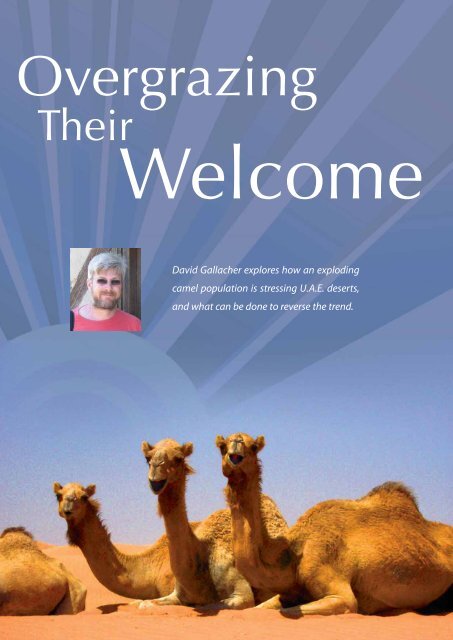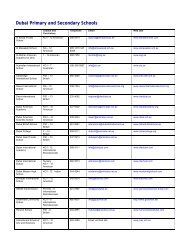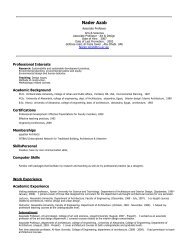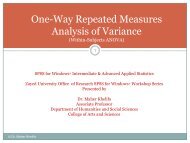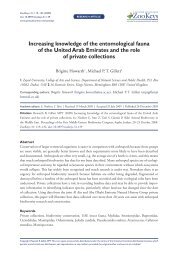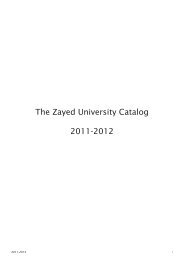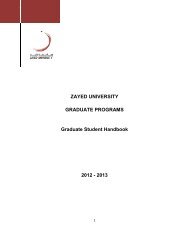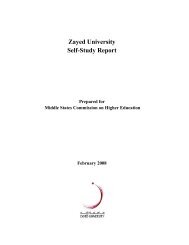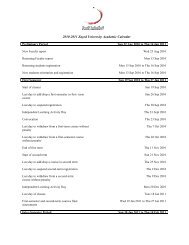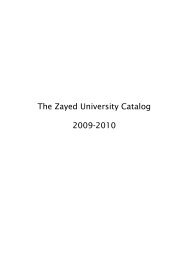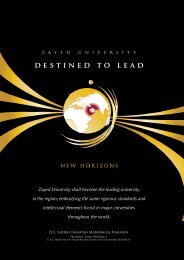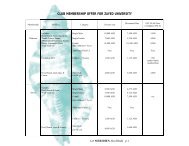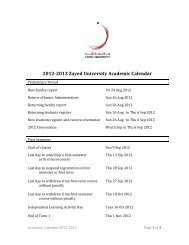Overgrazing their welcome - Zayed University
Overgrazing their welcome - Zayed University
Overgrazing their welcome - Zayed University
You also want an ePaper? Increase the reach of your titles
YUMPU automatically turns print PDFs into web optimized ePapers that Google loves.
<strong>Overgrazing</strong><br />
Their<br />
Welcome<br />
David Gallacher explores how an exploding<br />
camel population is stressing U.A.E. deserts,<br />
and what can be done to reverse the trend.
The greatest ecological problem facing the inland desert of<br />
the United Arab Emirates is excess grazing. Camels are the<br />
main cause in Dubai, though horses also contribute, and<br />
both goats and wild donkeys are a serious problem in other emirates.<br />
<strong>Overgrazing</strong> does much more damage than just reducing the<br />
amount of plant cover in the desert. It suppresses the populations<br />
of smaller native animals, such as rodents, hares and lizards, by<br />
reducing the availability of <strong>their</strong> food. With fewer small herbivores,<br />
the populations of native carnivores, such as cats, foxes and birds<br />
of prey, is also reduced. Plant biodiversity also suffers, with a few<br />
unpalatable plant species such as Sodom’s Apple and the sedge<br />
taking over areas previously covered by many more species. Some<br />
gravel plains near racetracks and large farms are entirely barren of<br />
vegetation.<br />
Over the past three years, I have studied the effects of camel grazing<br />
on rangeland ecology at the Dubai Desert Conservation<br />
Reserve. The research has focused primarily on contrasting the<br />
condition of sites grazed by camels with sites grazed by a mix of<br />
oryx and gazelles. Together with my colleague Dr. Jeffrey Hill of the<br />
Department of Natural and Quantitative Sciences, we have surveyed<br />
vegetation on each side of the fence separating the Al Maha<br />
Desert Resort from the rest of the conservation reserve. Our findings<br />
indicate that annual plants are hardly affected by grazing.<br />
However, almost all perennial species suffer, even those protected<br />
by thorns or chemical defenses.<br />
Arta, the beautiful small tree of the dunes, is almost completely<br />
removed by camels, but flourishes in the presence of oryx and<br />
gazelles. Meanwhile, other plants, such as broom bush (markh),<br />
have been reduced in size rather than number. Animals from hares<br />
to oryx use this shrub for shade and shelter, so it is likely that the<br />
reduced size of the plant under camel grazing could lower the populations<br />
of these animals. Although all habitats are affected by overgrazing,<br />
it is the flat gravel plains that are the most easily destroyed,<br />
probably because it is easier for camels to move across them.<br />
Camel numbers started increasing in the United Arab Emirates in<br />
the late 1970s along with many other rural enterprises. From an<br />
estimated base of 100,000, the camel population of the U.A.E. has<br />
grown to a current total of 250,000. In fact, the U.A.E. has one of<br />
Gravel plain on which most of the vegetation has been eaten by livestock<br />
A gazelle taking advantage of the shade offered by a large broom bush (markh)<br />
the greatest densities of camels in the world, second only to Qatar<br />
and 20 times the density of Saudi Arabia. The camels are sustained<br />
mostly on imported feed, since there is not enough rangeland or<br />
irrigated forage available domestically to keep them alive.<br />
Of course, not everything about camels is bad! The rapid rise in<br />
the camel population came about because of racing, a sport that<br />
reminds us of former times in the U.A.E. and helps to preserve the<br />
local heritage. Also, racing has become a major industry that distributes<br />
wealth throughout the community. Former President<br />
Sheikh <strong>Zayed</strong>’s stables alone directly employ 9,000 people, and<br />
many more are employed in businesses that provide feed, equipment,<br />
veterinary supplies and bloodlines.<br />
However, while the camel industry has provided great social benefits<br />
to the community, it has come at a cost. This cost is now<br />
being paid by native wildlife and the natural ecology, and also by<br />
camel owners who must pay to import a higher proportion of<br />
<strong>their</strong> livestock feed.<br />
ZAWAYA FEBRUARY 2007 31
Facts about camels in the U.A.E.<br />
◆ There are 14,000 actively racing camels.<br />
◆ 74% of all U.A.E. camels are female.<br />
◆ Camel milk has half the fat content of cow milk.<br />
◆ The U.A.E. has 15 camel racing tracks.<br />
◆ The family Camelidae includes the Bactrian (two humps) and Dromedary camels<br />
(one hump), as well as llamas, alpacas, guanacos and vicunas. The family is<br />
thought to have originated in North America.<br />
◆ There have been domesticated camels in the U.A.E. for at least 2000 years.<br />
◆ Body temperature can increase by as much as 6ºC before a camel starts sweating.<br />
Most of the U.A.E. is heavily overgrazed, but there is great reason<br />
to hope for the future. The desert ecosystem has an outstanding<br />
ability to recover after conditions have changed, whether the<br />
stress is a long drought or a change in land management. The<br />
roots of most plant species can survive many years, even when<br />
there is almost nothing left of the plant above ground. Some<br />
species can appear as a dead stump for several years before<br />
springing to life again. Therefore, most of the desert rangeland is<br />
able to return completely to its former state. All it needs is to be<br />
freed from the burden of overgrazing.<br />
If this happens, we may once again think it normal to spot a jerboa<br />
or a hare while walking in the desert, or to track the footprints<br />
A shelter hole in a broom bush (markh) that has been made by gazelles<br />
32 ZAWAYA FEBRUARY 2007<br />
of a red fox or a caracal. We’ll take for granted having a midday<br />
siesta in the shade of an Arta tree, admiring the beauty of its firered<br />
blossom. And perhaps, if we’re lucky, we’ll see a small group of<br />
camels grazing on the rangeland amid oryx and gazelles—just<br />
hopefully not too many camels. ❙❙<br />
More information about this research can be found at the ZU<br />
research Web site:<br />
http://www.zu.ac.ae/profile/David_Gallacher.aspx<br />
David Gallacher is Assistant Professor, <strong>University</strong> Seminar, <strong>Zayed</strong><br />
<strong>University</strong>.
Herd of camels walking through the Dubai Desert Conservation Reserve<br />
Footprints of a jerboa in sand wetted by dew Arta tree in full blossom<br />
A herd of Arabian oryx huddled in the shade of a small broom bush (markh)<br />
ZAWAYA FEBRUARY 2007 33


